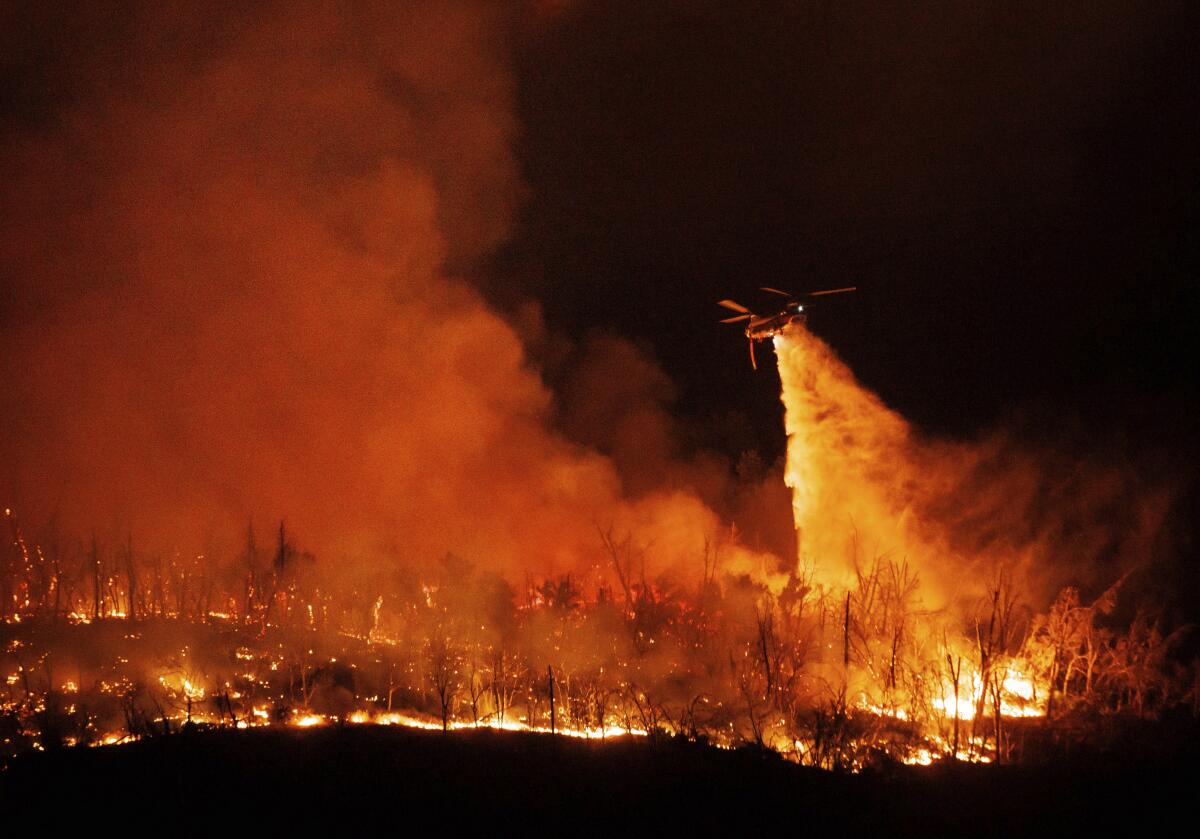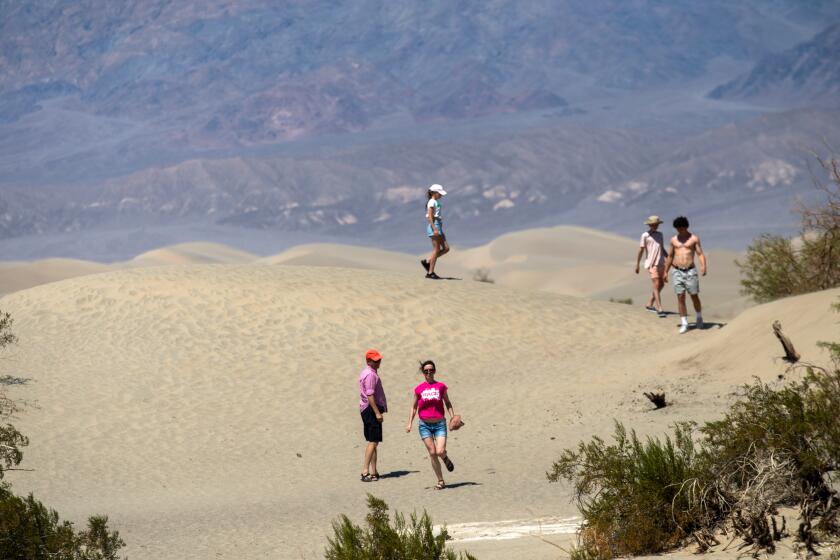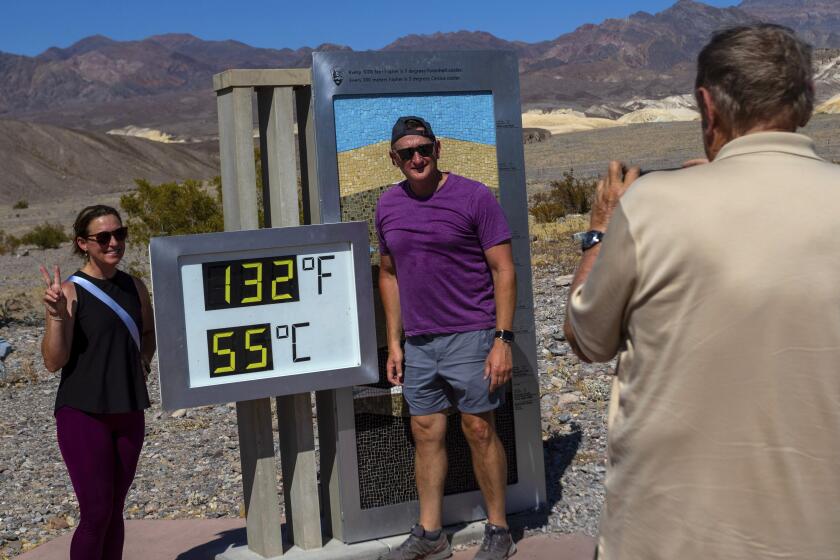First wildfire death of 2024 season reported as California heat wave continues

The first wildfire death of the 2024 season was reported Friday as California sweltered through scorching temperatures this week.
Human remains were found in a structure that burned Monday in the Mina fire near Covelo, Mendocino County officials confirmed. The body is still being identified by the coroner’s office but is believed to be that of a 66-year-old woman who was reported missing by her family. Officials said she had last been seen near the structure, where she was trying to extinguish the flames that began when a burn pile got out of control and started the wildfire.
The Mina fire first sparked Monday and has since burned almost 100 acres but was 85% contained by Saturday morning, according to Cal Fire.
The recent heat wave has taken a heavy human toll throughout the state.
As the temperature climbed to a record 128 degrees in Death Valley National Park, a group of motorcyclists was sickened by the heat, and one died.
Last weekend, a motorcyclist died in 128-degree temperatures at Death Valley National Park and a man died from heat in Sacramento. In the Bay Area, the Santa Clara County Medical Examiner was investigating 19 potential heat-related deaths as of Friday, including those of four homeless people, one in transitional housing and 10 older adults over the age of 65 years old.
During July alone, the Santa Clara Valley Medical Center Emergency Department treated 22 people who complained of heat illness, compared with 21 cases in all of June and 11 cases in May, according to an agency spokesperson.
Saturday brought a respite from the hot weather in Southern California, however. The National Weather Service predicted scattered showers and thunderstorms in Southern California on Saturday, along with some cooler temperatures over the weekend that could finally bring some temporary relief to the heat wave.
National Weather Service meteorologist John Dumas said despite potential wet weather and lower temperatures, fire risk may only increase. In a pattern referred to as virga, the moisture in the middle layers of the atmosphere will fall as rain, but evaporate before hitting the ground.
“Unfortunately, the lightning can still make it,” Dumas said, which might spark new wildfires.
A red flag warning has been issued until 9 p.m. Saturday for the mountain and foothill regions of Los Angeles County, according to the weather service, along with the Antelope Valley and valleys of San Luis Obispo and Santa Barbara counties, Ojai and Casitas Valley.
Dumas also said the heat will decrease by one or two degrees over the next few days, leading to “almost normal temperatures” by Monday or Tuesday before a new heat wave is expected to roll through Southern California.
So far, the 2024 wildfire season has resulted in more than 3,600 blazes that have burned more than 228,000 acres, scorching a far greater swath of land than the average for this point in the year. Fires have destroyed or damaged at least 148 structures, officials said. Several continued to burn Saturday.
The Bluff fire erupted suddenly Friday about noon near Banning in Riverside County, burning 50 acres and prompting an evacuation warning. The fire was 75% contained as of Saturday morning.
Temperatures across the West set several records this weekend, but the long-duration heat wave is forecast to continue across California for much of the week.
The blaze was first reported near Bluff Street and Mias Canyon Road, near the Banning Sportsman’s Club, according to the Riverside County Fire Department.
On Friday afternoon, Cal Fire issued an evacuation warning for north of Sunnyslope Cemetery, the entire Banning Bench area, west of Hathaway Canyon Road and east of Bluff Street, south of the Forest boundary. But after firefighters stopped the blaze’s spread by mid-afternoon, officials lifted the evacuation warnings around 5 p.m.
Also in Riverside County, the Pauba fire was first reported around 1:31 p.m. near State Route 79 and Pauba Road in the Temecula area, Cal Fire said. The blaze had burned 101 acres and was 50% contained.
In San Bernardino County, the Vista fire had scorched more than 2,800 acres and was 31% contained as of Saturday morning, , according to Cal Fire. The blaze first ignited July 7 around 10 a.m. near Lytle Creek; evacuation orders were issued for the Mt. Baldy Ski Resort and the Pacific Crest Trail from Lytle Creek to Mt. Baldy.
The Mojave Desert Air Quality Management District warned about poor air quality in the Victor Valley area due to smoke from the Vista fire. The advisory is in effect through Sunday.
In Santa Barbara County, the Lake fire — the largest active blaze in the state — was 19% contained Saturday morning after scorching 38,004 acres, according to Cal Fire. The blaze began on July 5 and grew quickly as firefighters on the ground struggled to access the flames despite persistent heat and difficult terrain.
Three recreational residences were destroyed and an outbuilding and campground was damaged, according to officials. At one point, the fire came within a mile of Sycamore Valley Ranch, formerly known as the Neverland Ranch owned by Michael Jackson.
Capt. Scott Safechuck, spokesperson for the Santa Barbara County Fire Department, said Saturday morning that more than 3,400 personnel were working around the clock to extinguish the fire.
Crew members have made a “visible difference” on the south side of the fire, where flames could previously be seen from Santa Ynez and the Lake Cachuma area, Safechuck said.
Despite unusually high temperatures in the evening that worsen fire risk, firefighters had made some nighttime progress with controlled burns of dry vegetation and a helicopter that dumps water in the dark. Those coordinated efforts have “really been successful for us eliminating a lot of the threat on the south side,” Safechuck said.
“That is really good for community safety, because that’s where a lot of the structures were threatened,” he said. “We are making a huge improvement in that area.”
Firefighters are still working to control the burning in the backcountry, where challenging terrain has made it more difficult to extinguish the hot spots. Safechuck said fire crews have wrapped structures in the line of fire with aluminum foil-like material to prevent their burning.
The increased danger of heat waves is not occurring equally in all regions — in the hot, dry conditions of the Southwestern U.S., heat wave intensity and frequency is increasing particularly rapidly.
The heat wave that has scorched California for several days has only made fire conditions worse.
For the Los Angeles area, thunderstorms forecast over the weekend could raise the risk of igniting new wildfires.
Thunderstorms are expected to move in from the southeast Saturday afternoon and move over the mountains and deserts of Los Angeles County, the mountains of Ventura County and interior portions of San Luis Obispo and Santa Barbara County, according to Joe Sirard, meteorologist with the National Weather Service in Oxnard. There’s a 10% chance of showers over the coasts and valleys of L.A. County.
Rainfall amounts will be highly localized and difficult to predict, depending on the location. Elevated fire conditions continue to be widespread across Southern California due to high temperatures. Sirard warned residents to avoid activities, such as campfires, that could ignite flying embers.
“Any lightning strikes ... could spark new fires so that’s obviously a concern,” he added.
Due to high temperatures in the Palm Springs area, California State Parks closed the Skyline Trail at Mount San Jacinto State Park. Hikers have been rescued during recent heat waves due to dehydration and heat exhaustion.
More to Read
Sign up for Essential California
The most important California stories and recommendations in your inbox every morning.
You may occasionally receive promotional content from the Los Angeles Times.
















